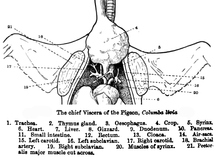Syrinx (bird anatomy)

1: last free cartilaginous tracheal ring, 2: tympanum, 3: first group of syringeal rings, 4: pessulus, 5: membrana tympaniformis lateralis, 6: membrana tympaniformis medialis, 7: second group of syringeal rings, 8: main bronchus, 9: bronchial cartilage

Syrinx (Greek σύριγξ for pan pipes) is the name for the vocal organ of birds. Located at the base of a bird's trachea, it produces sounds without the vocal cords of mammals.[1] The sound is produced by vibrations of some or all of the membrana tympaniformis (the walls of the syrinx) and the pessulus caused by air flowing through the syrinx. This sets up a self-oscillating system which modulates the airflow creating the sound. The muscles modulate the sound shape by changing the tension of the membranes and the bronchial openings.[2] The syrinx enables some species of birds (such as parrots, crows, and mynas) to mimic human speech. Unlike the larynx of mammals, the syrinx is located where the trachea forks into the lungs, and because of this some songbirds can produce more than one sound at a time.[citation needed]
See also
Notes
- ^ Terres, J. K. (1980). The Audubon Society Encyclopedia of North American Birds. New York, NY: Knopf. p. 995. ISBN 0-394-46651-9.
- ^ Direct observation of syringeal muscle function in songbirds and a parrot Ole Næsbye Larsen and Franz Goller, The Journal of Experimental Biology 205, 25-35 (2002)
